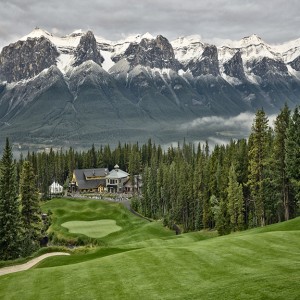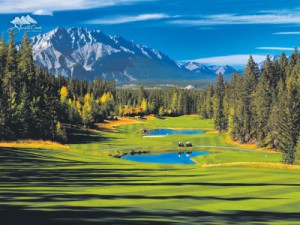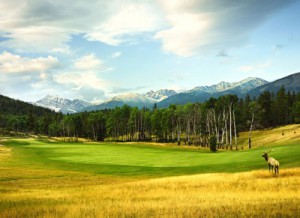Editor’s Note: This article was first published by Cascade Golfer Magazine.
CANMORE, Alberta Canada — Even from several thousand feet above them, the Canadian Rockies are awe-inspiring.
The view from my third-row window seat featured snow-capped mountain peaks, too many lakes to count, and lush green valleys, a combination that assured me that “Golf That Inspires” — the tagline of Canadian Rockies Golf, who had invited me on a six-day golf adventure representing Cascade Golfer Magazine— was more than just a slogan.
As the plane continued its descent into Calgary International Airport, following barely a 90-minute flight from Seattle, a golf course came into view. From 20,000 or so feet above the ground, the dark green fairways and white sand traps stood out, and I wondered if that was one of the five golf courses I would be playing over the next six days.
It wasn’t, but as I soon discovered, there are enough superb courses in western Alberta to more than satisfy any golfer. Not to mention a plethora of other activities to keep you busy, like rock-climbing, horseback riding, kayaking, fishing and bicycling.
Clearing customs was a breeze, taking about two minutes to negotiate a short line and engage in a brief chat with a customs agent, who asked why I was in Canada and how long I would be there. He must have been a golfer, as there were no further questions.
My host for the week was Canadian Rockies Golf, a collection of golf courses located in this historic, dramatic and largely untamed mountain destination. Founded in March 2009, the CRG currently offers stay-and-play opportunities at six golf courses in five locations, including three Canmore-based properties (the Canmore Golf & Curling Club; Stewart Creek Golf and Country Club; and Silvertip Golf Resort) and two Fairmont properties designed by the legendary Stanley Thompson — Banff Springs and Jasper Park Lodge. (The popular Kananaskis Country course remains part of the consortia as well. Ravaged by a 100-year flood in 2013, the facility received funding last October to completely rebuild the Robert Trent Jones-designed course, with a projected re-opening in 2017.)
The legendary Thompson is to Canada golf design what Robert Trent Jones, Sr., is to America. Thompson designed more than 200 courses during his epic career, most of them in his native country. Banff Springs and Jasper Park were constructed with horses, wagons, picks and shovels in the 1920s, yet are so good to this day that both are continuously ranked among the top-10 courses in the country.
And with the U.S. dollar worth 20 percent more than the Canadian buck, now is a good time to visit our northern neighbors. The golf is great and the scenery is even better.
“Our objective is to have people from the (United) States look a little farther north,” says Gordon Schultz, President at Golf Canada’s West Ltd. “We can send pictures, but until you see it, you don’t know. Almost to a person, the reaction has been, ‘I had no idea.’”
I’ll admit it — I had no idea that what I was about to experience was destination golf at its best.
A pre-round briefing at Silvertip Resort stressed the importance of being aware at all times — because we were in bear country.
“If you encounter a grizzly bear, stop and evaluate the situation,” I was told. “Identify yourself by speaking in a calm, appeasing tone. Back away slowly, preferably in the direction you came. Walk, don’t run, and keep your eye on the bear so you can see how it will react.”
Gulp!
“If you encounter a black bear, hit it with rocks, pots, pans, sticks or fists – anything handy. The odds may seem against you in a fight, but bears generally do not see humans as prey, and a bear that makes a predatory attack is usually immature, starving or wounded, and may easily be scared away if you hit it.”
Double gulp!
My choice would have been the 4-rescue club, with emphasis on “rescue.” But, I didn’t encounter either kind of bear on the course, which offered plenty of its own beauty and challenge. My two favorites were No. 15, a 145-yard, par-3 over water looking directly at multi-million dollar homes and a section of the Canadian Rockies, and No. 18, a 415-yard, par-4 with a 600-foot elevation drop from tee to green.
If you like elevated tees, this is the place to go. It feels like you’re standing on top of the world on nine different tee boxes at Silvertip. Continuing the theme, I capped my round with a 12-minute excursion aboard a chopper from Alpine Helicopter, including closer views of the Three Sisters (Faith, Hope and Charity), before dinner (a delicious Elk burger) at Tavern 1883 and visits to a couple of local watering holes.
Of the three golf courses I played in the Canmore area, Stewart Creek Golf and Country Club is the baby of the bunch. It opened in 2000 and has received numerous awards for preserving the natural habitat, and was named a Certified Audubon Cooperative Sanctuary by Audubon International in 2004.
For a course that is nestled so close to the mountains, the fairways are remarkably level from tee to green, preventing side-hill lies. There are some water holes, the most daunting being on No. 18. Hit your approach shot just a few yards to the left and it’ll go splash. Also, be sure check out the entrance to a mine shaft, located on the left side of the 14th hole.
After the round, I boarded a luxury motor coach for a four-hour ride to Jasper and the Fairmont Jasper Park Resort – a journey on a mostly two-lane road past numerous glaciers, lakes, rivers and wildlife. The driver, Michelle, provided the commentary and mentioned that despite numerous such trips, she never takes the incredible scenery for granted.
“In my mind, it’s the most beautiful drive imaginable,” she said.
After a night’s rest at the Fairmont Jasper Park’s Milligan House, an eight-bedroom, eight-bath log cabin with an expansive meeting room in the middle, I made the short walk over to the resort’s renowned golf course for one of the most pleasant rounds of golf imaginable.
By the fourth hole, I couldn’t help but wonder how in the world Stanley Thompson pulled this whole thing off. Without any heavy machinery, fifty teams of horses and 200 men turned an area of rock and trees into a gem of a golf course that has stood the test of time. Trains hauled in loads of topsoil to spread over the rocky soil, ensuring that the course would drain well to this day. Nearly 100 years later, the Jasper still ranks among the top five golf courses in Canada – and is No. 1 on several lists.
The Jasper course underwent some alterations during its first 70 years, but in 1994, course staff used Thompson’s original blueprints to help restore the course to its original layout. Bunkers and tee boxes received special attention, with many of the tee boxes now incorporating boulders that were unearthed during the restoration.
Clouds obscured portions of the mountains, but our “four seasons” round was superb. It rained on us a few times and hailed on No. 8, but the sun eventually came out and the clouds lifted enough in the late morning for us to get a good glimpse of the peaks that rise more than 10,000 feet, adding to the overall beauty of the 6,663-yard, par-71 course. The featured hole is No. 14, a 355-yard, par-4 over the edge of a lake.
A friend of mine once wrote that Banff is his “favorite place in North America.”
I can see why. Thompson must have played in the sand quite often as a child. How else could you explain building 147 sand traps into the design at the Fairmont Banff Springs? One golfer in my group landed in 14 of the bunkers, two more than me. On the picturesque No. 14, there are six sand traps separated only by small strips of grass. Your approach shot onto the green, however, gives you a stunning view the world-renowned Fairmont Banff Springs Hotel, also known as the “Castle in the Rockies.”
Virtually every hole on the 18-hole, 6,938 yard, par-71 course has its own personality – none more so than No. 4, a slight downhill, 165-yard, par-3. “Devil’s Cauldron” is so well-regarded, in fact, that it was once selected as one of the top 18 holes in the world.
My final round of the week came at the semi-private Canmore Golf & Curling Club, which, in addition to being the least flashy of the courses I played, was also the only one with a price tag under $100.
Schultz summed it up the best, noting that “Canmore is sort of like going to Cheers, where everybody knows your name.”
The club boasts more than 600 members — no surprise in one of the world’s most outdoor-active communities. (Nearly one-third of the city’s 15,000 residents have a membership at the nearby Elevation Place, a 77,000-square-foot facility that includes, among other things, an eight-lane swimming pool and 60-station rock-climbing structure.)
Despite the high number of regular members, leading to about 34,000 rounds per year, 90 minutes of tee times are set aside each day for the public, who must remain focused on the narrow fairways, as opposed to the top-notch views. As my scorecard would attest, it’s a challenge easier said than done.
As my flight lifted off the following morning, I reflected on the week — six days in some of the continent’s most beautiful country, playing incredible courses, dining on steaks and unique local fare, and holing up at some of the most luxurious resorts in all of Canada. Schulz had suggested at the start of the week that I “had no idea,” and he had certainly been proven right.
Now I know.
























